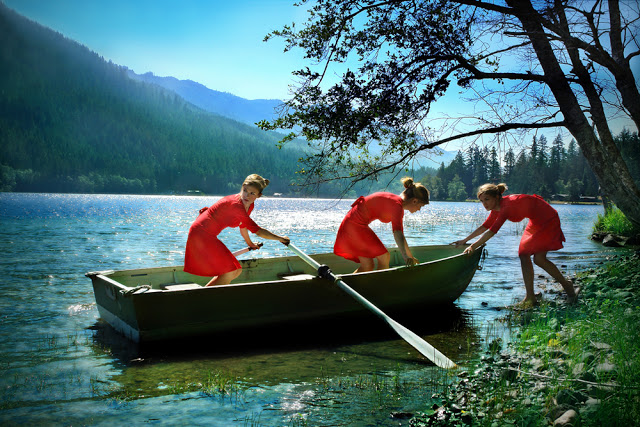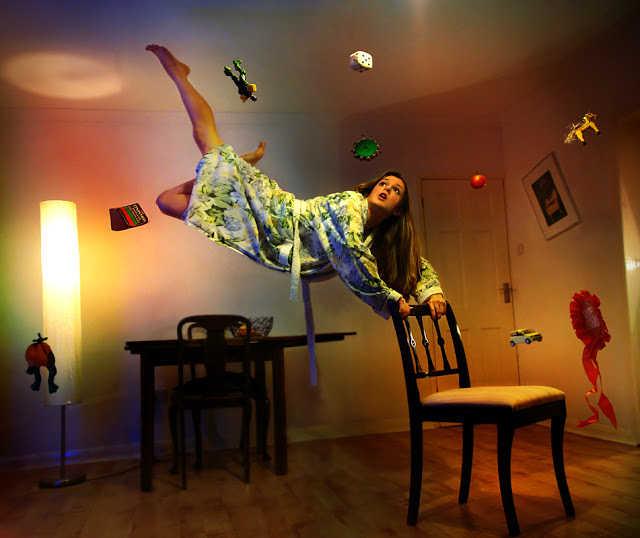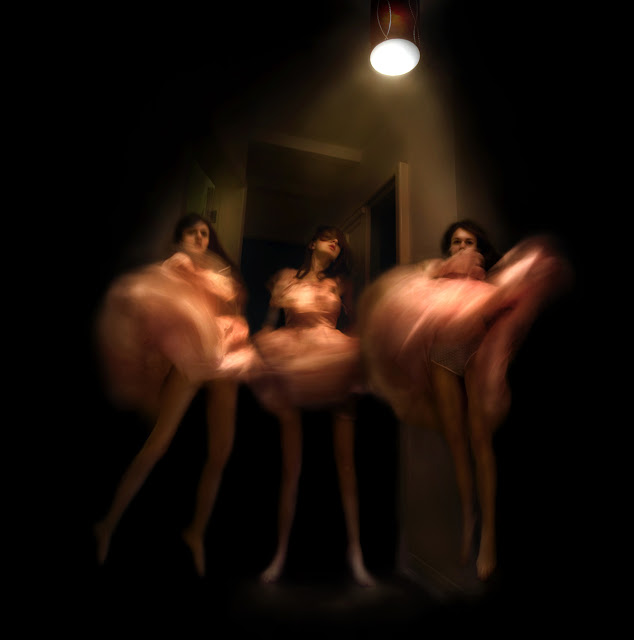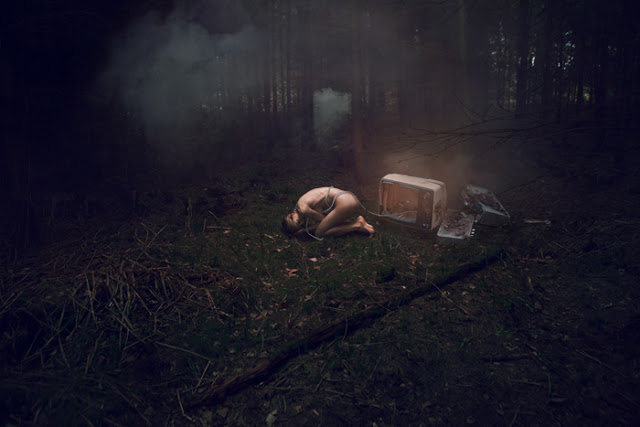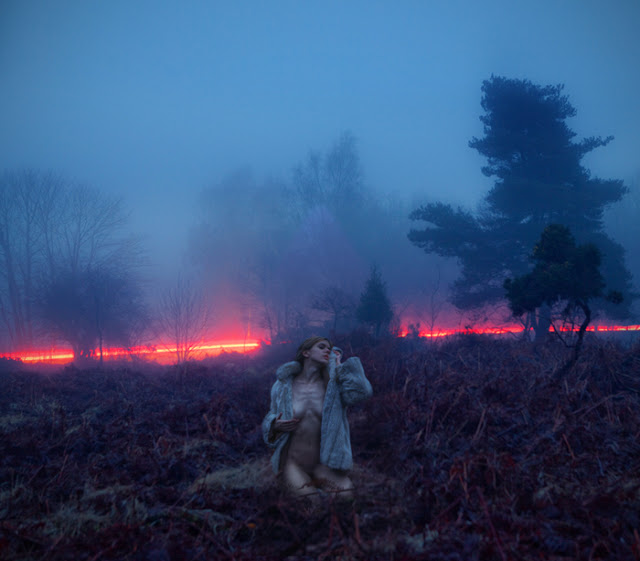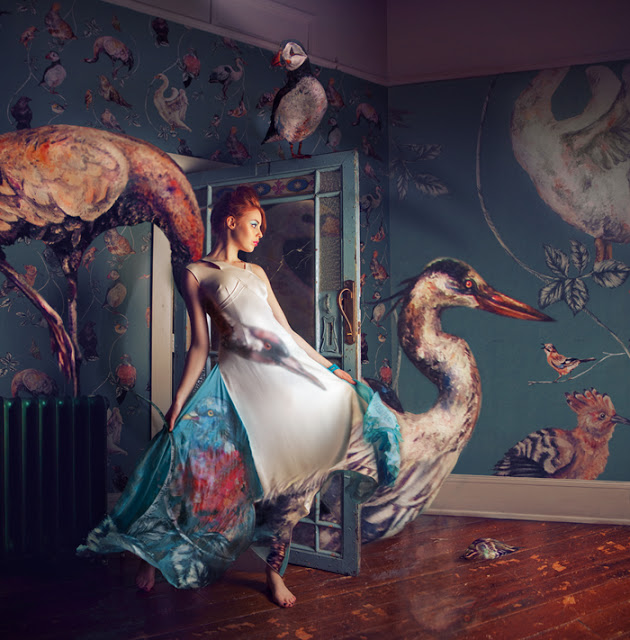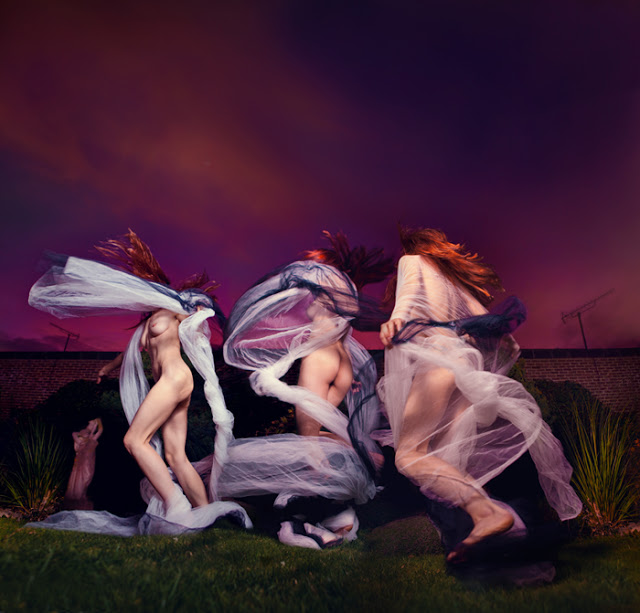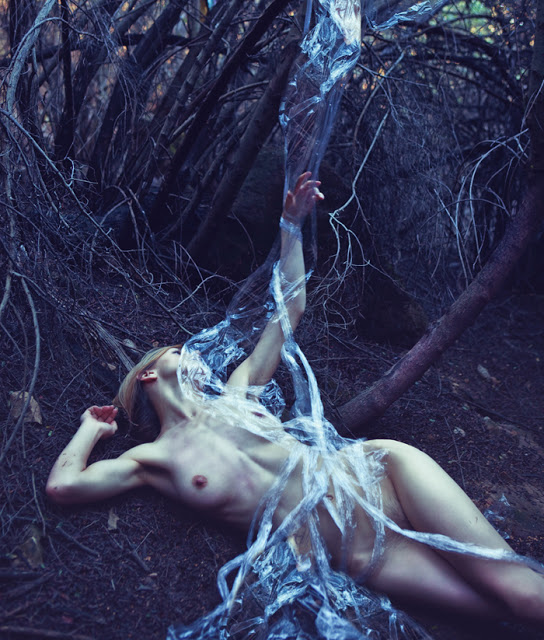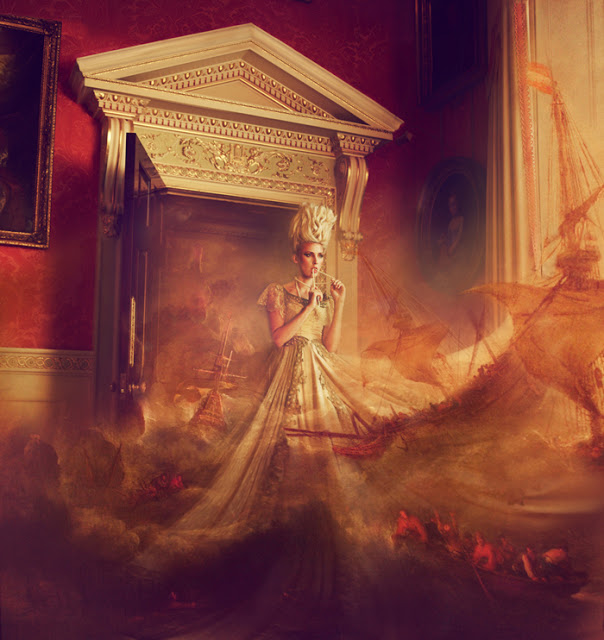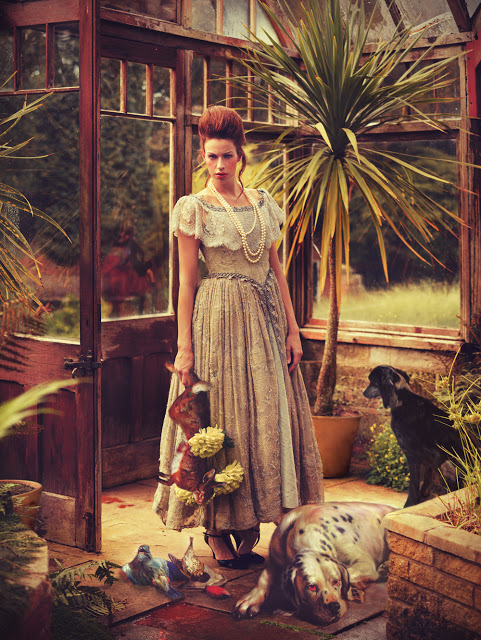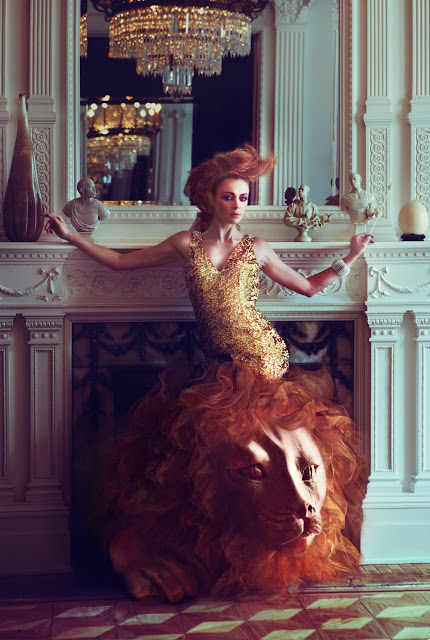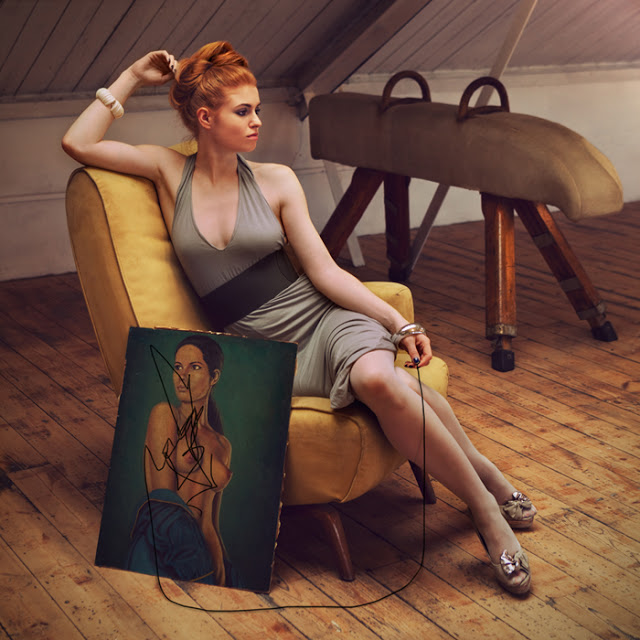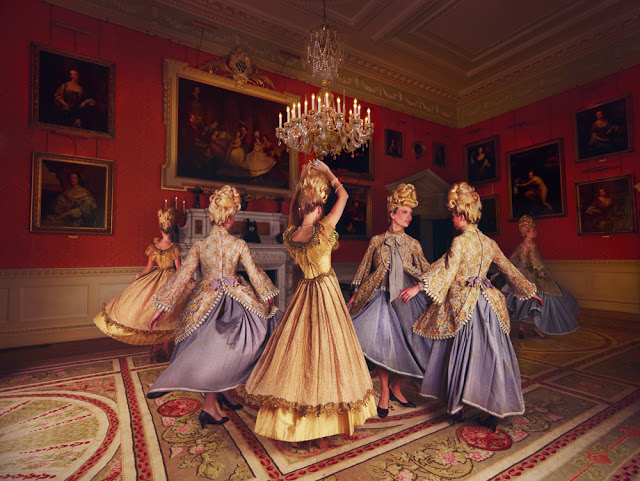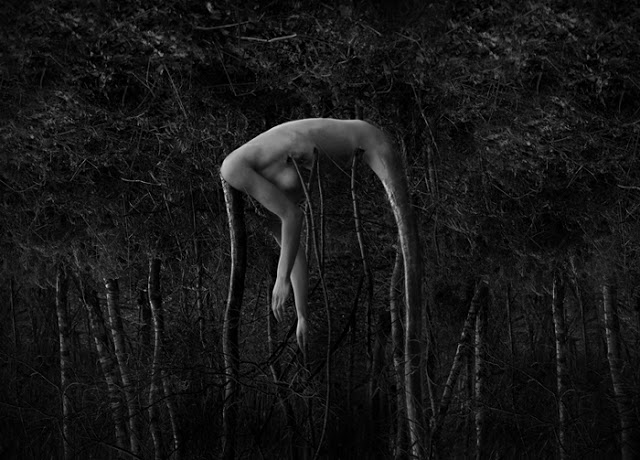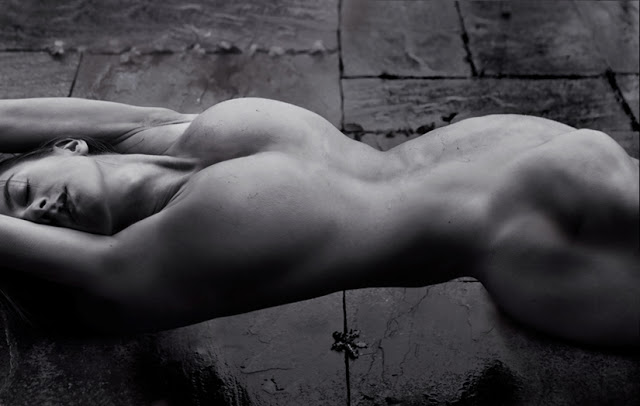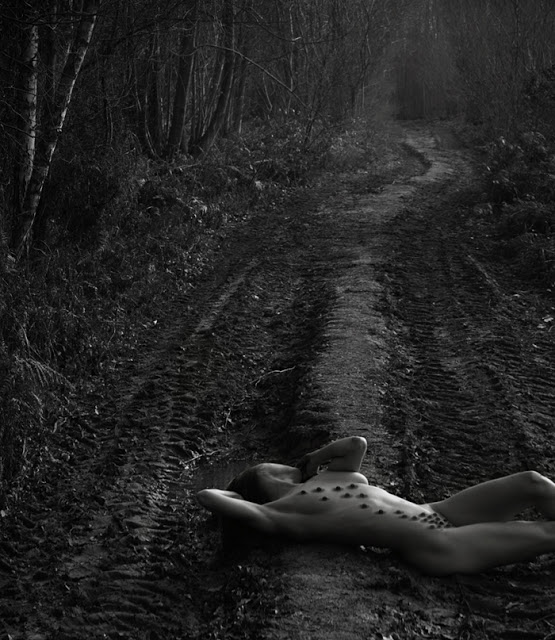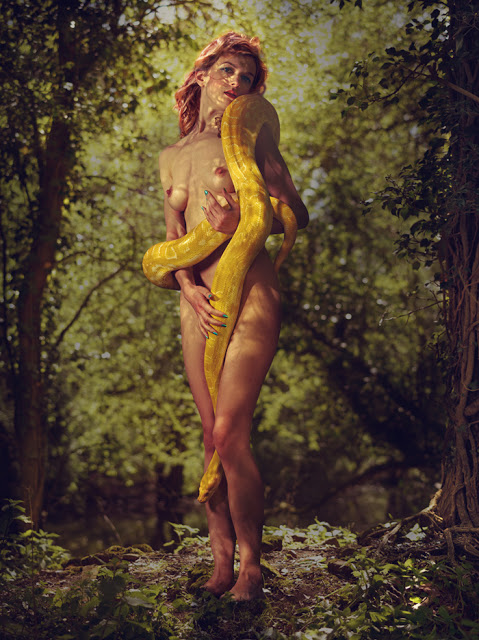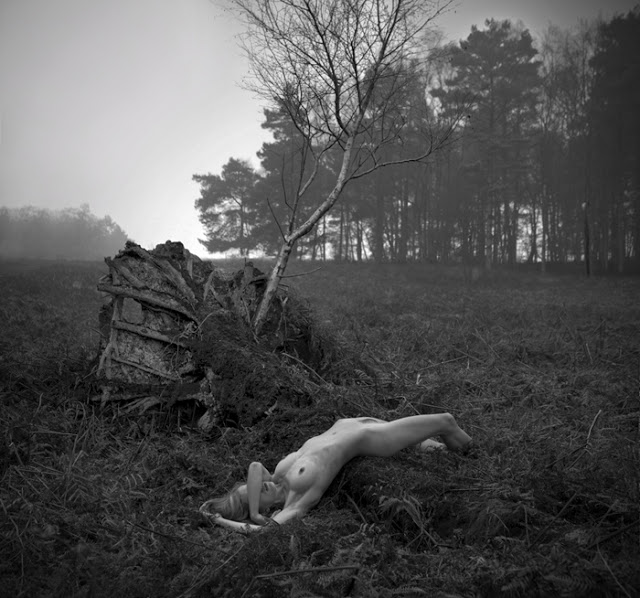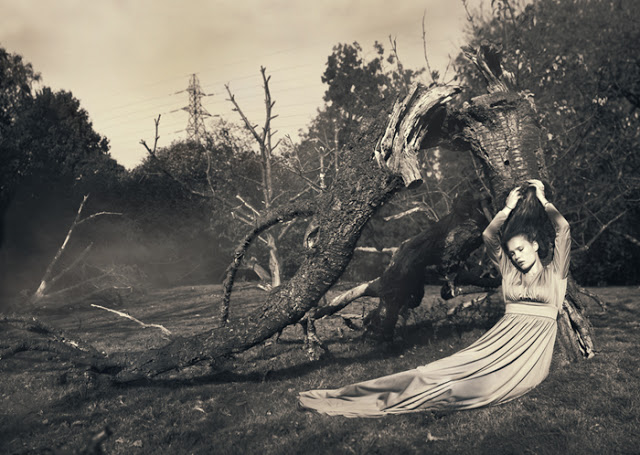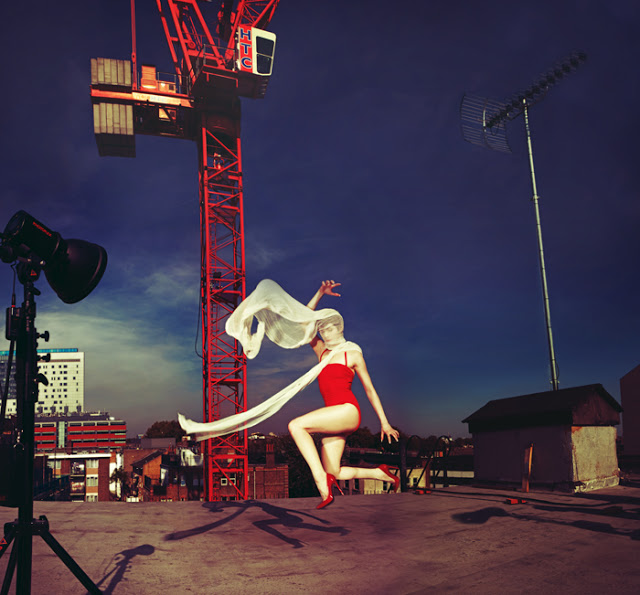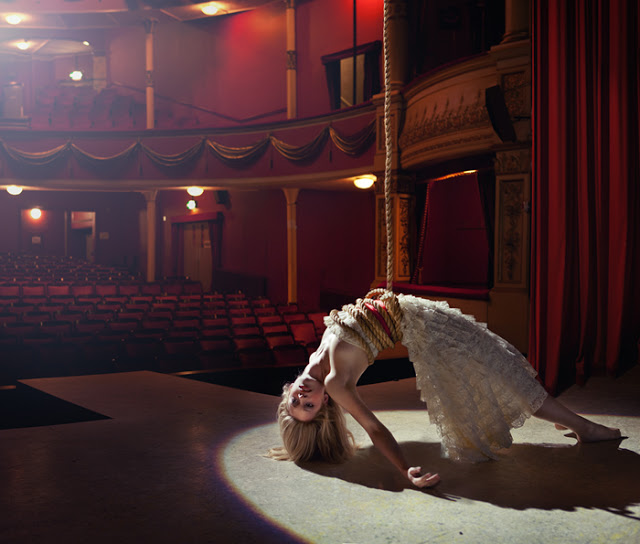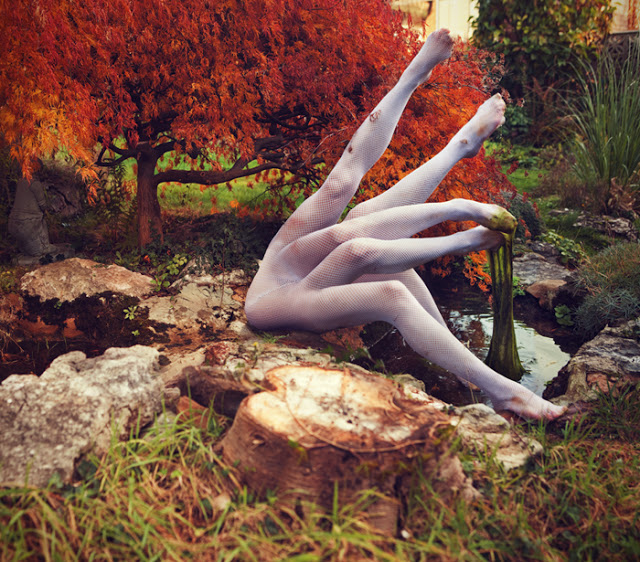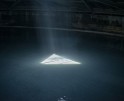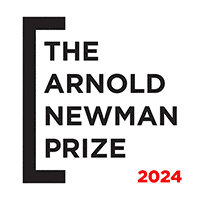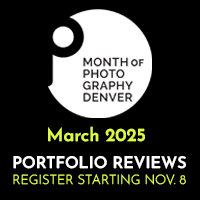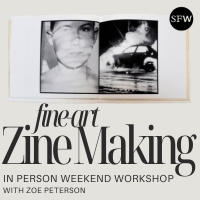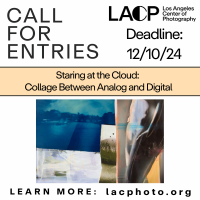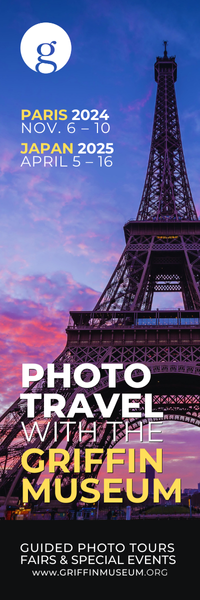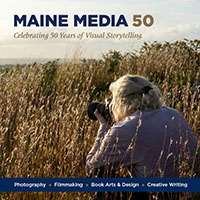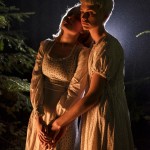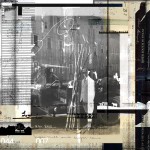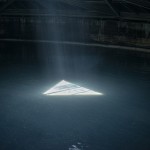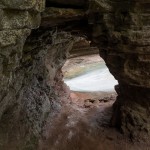I first saw the intriguing and surreal photographs of Miss Aniela five or six years ago. It was one of those visual encounters when late at night you have gone down the rabbit hole of links and come across work by someone who is of an age where they still can’t legally buy a drink (in the U.S.), and it leaves you slightly depressed. But I wasn’t the only one discovering her photographs–her images and her story was gobbled up by blogs and e-zines all over the world and Natalie Dybisz (aka Miss Aniela) became an overnight internet sensation.
Recently I was interviewed by Fabiano Busdraghi of the Camera Obscura blog/magazine, and Natalie happened to comment on the interview–it was then that I realized that she was working through her own idea of success, how to navigate it and how to achieve it, and that she would be interesting person to interview. How does someone who has had so much acclaim at the beginning of their career sustain that momentum, and then how does someone grow, experiment, and make mistakes in front of a watching public? And for Natalie, most importantly, how does she move from fine art phenom to working equally successfully in the commercial and editorial worlds?
Let’s start at the beginning. What drew you to photography and at what point during University did you know that it was what you wanted to pursue?
My foray into photography happened whilst I was at University, but studying something else. It was an English and Media degree, during which I discovered other artists/amateurs around the world sharing their work on the internet, and to my surprise, openly sharing their self-portraiture. This re-awakened a desire to take pictures (I had had a brief stint with self-portraiture a few years earlier with a digital camera loaned from my college’s art department) but here, the artist pseudonym ‘Miss Aniela’ was born, Aniela being my middle name, and a new body of work emerged which I started to share online. Being a creative person, photography became the appointed vocation, mainly through the allure of the immediacy of digital photography. Self-portraiture began for me as a somewhat shameful habit, so I liked the private process of being able to take a picture of myself, see my results straight away and take it forward to experiment in processing, always in control.
The Escape
It seems that you had huge successes while still in school–did that success impact your college experience?
I made a lot of images (though I didn’t think of it so ‘professionally’ then) and had my first exhibition locally in Brighton, started to sell some prints, and whilst that’s certainly a great start, I guess I never saw it as groundbreaking. I have always been hungry for massive things, in fact, so much so that I’ve have to curb that humongous desire a bit to avoid being naïve about how quick ‘success’ can happen, and indeed, how meaningful quick successes really are. However, in answer to your question, I still had plenty of time to attend my lectures (the schedule was quite laidback!) and get a first… it was the employment I entered afterwards that was promptly disrupted by growing photography opportunities.
The Adrenalin
It also feels like your work was well ahead of the visual learning curve– the kind of self portrait imagery that you were (and are) exploring at that time was quite unique. I remember seeing your work 5 years ago and your visual voice was so powerful right from the beginning….
Thank you, I think the biggest compliment people can make is when they speak holistically about my work and about me as the creator – when they suggest that I have a ‘voice’ that not only uses the skills of photography but the creativity, ‘talent’ or so on – it suggests respect and longevity which is ultimately what any artist wants in their life.
On another note, it’s interesting you mention seeing my work from 5 years ago – it does make me wonder when people mention having known my work for a long period of time who I wouldn’t have imagined seeing it. It makes me hope for more of those onlookers to reach out – the smallest spurring-on from others in the art industry can be uplifting and leveraging.
IV TV
Having achieved so much publicity and accolades at an age where most other photographers are still finding their way, does it feel like you missed your “photographic childhood”?
I feel that my photographic ‘childhood’ is my initial foray into photography, the self-portraiture from 2006-2009 which gained a lot of attention. But there was a question of where the attention was going and getting into the right circles, and I knew my dream was to make a long-term impact. It was also a ‘childhood’ because I am happy to consider that phase a fun and memorable period of letting loose, experimenting and setting foundations to who I am now: what I would call the more refined ‘adult’ who has more of a focused consciousness on what they are doing, manifested specifically in my current work, and everything that work suggests of my future direction.
Also, as this new ‘adult’, I feel as though I can and will attain more rounded respect and not just a single-faceted ‘wow’ at a technique employed as in my earlier work. Another major thing I am noting is the mileage to be had in sharing one’s work in new circles, accessing more places on the ‘internet map’ than the known territories of mostly unprofitable photo-sharing sites, just taking advantage of the many opportunities both virtual and physical to get one’s work into different contexts that can be more intellectual, lucrative, or both.
Undoubtedly you are a popular image maker with close to 11,000 FB fans and have influenced a whole generation of young photographers… Do you feel a responsibility to your fan base? And do you feel you have to stay creatively one step ahead?
Those are good questions. In terms of ‘responsibility’, yes and no. Yes, because the nature of my work, by which my popularity/profile has been raised, is something that should be noted and observed as inherent to my ‘brand’ as a creator, in order to keep that accrued audience satisfied. But then sometimes the notion of a ‘brand’ is at odds with being an ‘artist’, which is about being true to your fluctuating, complicated self. But surely in either case, the audience is exactly that – the audience – who have chosen to come and view whatever you are putting out, there is something they like and trust about you. I have always remained true to following my instincts and expressing what most stimulates me; the only troubles have laid in the continuous self-doubt of how exactly to build, extend and monetise that audience to be able to make a living from art.
To some degree, the ‘Miss Aniela’ name has become a bit of a brand, with my partner Matthew on board as a business, the name through which we sell our workshop-style event (big, laid-on fashion shoots) and pursue clients. But it will always be an artist-led ‘brand’. I will always put out what I am passionate about, whether it’s a piece of new work or an event where I show people that being a photographer is about ‘doing it for yourself’. I would not feel comfortable otherwise. Miss Aniela is only a ‘brand’ in terms of taking on an ostensible form and structure that resembles a business. Behind that, I am always a thinking feeling artist.
Deliverance
I do feel inclined to keep ‘one step ahead’, but that’s mostly because I naturally veer away from trends and ‘what everyone else is doing’, at least, from the things that become hyped or mass-trends (I dislike that in any form: music, film, TV etc). So, in my personal artmaking, it’s a natural in-built mechanism that keeps me moving from one thing to the next, when one thing feels ‘done’, I can rarely produce another perfunctory image to fit alongside it, no matter how much it might keep the momentum of my audience’s lips moving. I talk here in particular about techniques: a good example is my phase of ‘levitation’ photography which I unpick at length on Fabiano Busdraghi’s Camera Obscura blog.
But I’m also referring to other phases: phases of feeling/desire (e.g. my fairly lighthearted ‘cloned’ self portraits), or being drawn to a particular location (doing a series with abandoned buildings from which I made a dedicated self-published book).
Her Fleeting Imprint
And then, currently in my Ecology series, I am expressing a more troubled outlook, rather than using the subject as a character in a fantasy world, it moves towards inferring the crumbling infrastructures of our real world – a shift from the personal to the environmental, but with the human element and often still using myself as a model. This series is fuelled by my personal phase of having the urge to just go laying naked outdoors, to present a ‘stripped down’ scene of starkness, with other elements such as litter, ironic objects, and surreal distortions at once alluring and revolting.
My series ‘Surreal Fashion’ began as playing around with fashion portraits, trying to make them more contextual and interesting – and also, for them to take on a different appearance in post-production that would transform them from just being a shot anyone could take in that highly contrived, ‘styled’ situation. I find that a lot of fashion photography has that ‘samey’ look to it, and I wanted to take the images a dimension further. Inspired by the paintings and objects in the locations where I shoot the portraits, I’ve started to incorporate them into the actual photos, giving the objects/paintings a new lease of life, literally re-animating them.
Storm Door
My favourite one was in making a painted sea spill and crash around a model in ‘Storm Door’. The painting was in the adjoining room, and had previously frustrated me with inspiration I did not know how to vent! The picture became my way of consuming it, in a creation of my own.
In this series, it’s hard to ‘plan’ exactly what I will do with a prop – I just get a feeling that something will happen with it, and I play around with possibilities. So I am able to keep it growing into a ‘series’ because the main criteria is that it involves an object taking on a surreal force within the image, and together, all the images become like a colourful tapestry. I am aware that some of the images are less suitable for the commercial interest of fashion than others – it is the more subtle ones that become part of my actual fashion stories. On the whole though, my goal is to exhibit the best of the series, as they have already proved enticing to print-buyers.
How is that recognition impacting your current desire to make commercial work and get a foot hold into that market?
Gaining commercial work is very important to me, because my idea of success of having someone believe in my ability to create, and the trust that I will create what they want. The same applies to fine art: having a gallerist or curator believe in my work and vision.
I know what it is like to be so compelled by someone else’s work: no matter of the age, credentials, or any other factor, you just ‘know’ that someone has ‘it’. That ‘it’ is like love, it becomes the meaning of life, the feeling that defies fear of mortality! An example is the contributors whom I choose for my books, like you have said about your own blog, going beyond ‘me, me, me’ is the next level of self-fulfilment in that you are helping share other talent with the world. Passion for art is like a common language, but unwritten or unspoken; it is about just feeling the conviction that someone’s work needs to be seen, shouted from the rooftops. I also feel this way when I meet an astounding model or hairstylist. I love meeting people who are – genuinely – passionate and hungry, who never rest (even to their detriment), who are so serious about making something happen that goes beyond money or logic. The bonus is when you can meet someone who does also have a sense of business and logic – whose passion doesn’t send them completely to cuckoo land! For that is how dreams and wishes become real and serious. I strive daily for that balance, and to convey it, as well as find it in others.
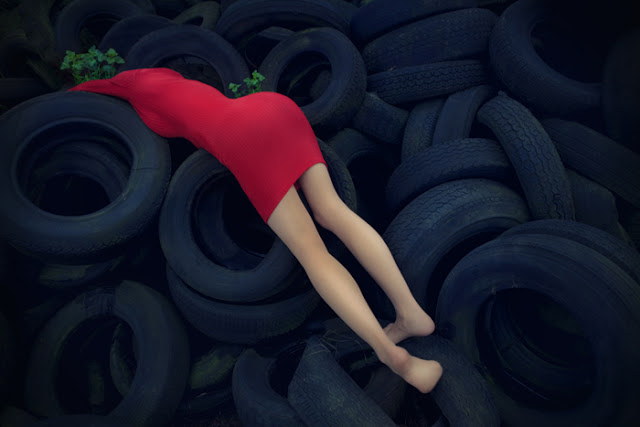
Retreaded
Do you want to straddle both the worlds of fine art and editorial/commercial photography?
I do want to straddle both, and I’m realising it is possible, as long as focus is applied in equal amounts to both – which is the tricky part. Sometimes I get lost wasting time in the blurry worlds in between the two – entertaining an audience online, doing admin or simply procrastinating. Then there is also another facet to my work which is the fashion shoot events we hold in different countries, which takes a lot of organisation, but my partner oversees most of that, and the events themselves lend well to the creation of the fashion work that I am currently submitting to magazines and using to get a foothold into fashion, as well as building my art/fashion fused series which I’d like to exhibit too.
Harmony String
I see other photographers able (and indeed, almost obliged) to pursue commercial photography of all kinds as well as keep doing their ‘personal’ projects. So I see it as no matter that I have to do the same – but I relish the idea of commercial projects, in working with budgets large or small, to put together productions, and make ‘art’ happen, albeit commodified. My partner Matthew and I live and breathe photography, we are constantly thinking of new ideas, and whilst waiting for clients, we get busy making our own productions happen. We are genuinely connected to the creation of art using whatever means we have at hand: whether that’s a reflector, smoke bomb, and my naked body in a spot of woodland, or a 17th century stately home with thousand of pounds of lighting and 6 models in full Regency attire.
Another Whirl
How does it feel to expose so much of yourself through your work, physically and mentally?
I used to expose more of myself mentally, as in ‘personally/anecdotally’, through journalistic dialogue alongside my images. This became a drag, because as well as my work becoming reminiscent of a sighing teenage girl’s diary, I just felt as though it undermined the work a bit. Now I separate the two more, and use places like Twitter as an anecdotal outlet, and give my work some conceptual breathing space.
But, I am an artist who likes to ‘talk’. I engage regularly in the written word in different ways, but I try to balance it out by blending the technical, artistic and anecdotal together: ultimately to engage with people and not encourage the saturation of any of element. A key example is how I write my books – in my most recent book Creative Portrait Photography, I try to talk about the whole process of creation, showing the story behind the making of an image including the tools, the intentional thinking, and the surprises. I also get involved as much as possible with speaking engagements at fairs and events.
Parasite
On a level of physical exposure, I am exposing myself naked even more than ever. It stems from an increasing yearning to take the focus off the exclusively-male titillation element, and instead stand exposed on my own terms, as a female human body that is not just always sexually suggestive, but also can be, quite unashamedly – after all, sex is fundamental, and a massive part of our consciousness, it is life itself. And sometimes I even take a sensual or suggestive pose and choose not to settle for its beauty or simplicity, and play on the viewer’s expectation, almost to subvert or disrupt the subject’s vulnerability to the gaze of the spectator.
The Corkscrew
The Invasion
The milestone where I really felt as though I was ‘exposing’ myself physically and sacrificing myself to my art was when I did a shoot naked with a python last year, to produce an image inspired by John Collier’s Lilith and Evelyn de Morgan’s Cadmus and Harmonia (my image ‘Double bind’). I walked about naked in front of the team on the day, who were to that point strangers. I also put out a ‘behind the scenes’ video showing myself wandering around starkers and thought, well, that’s it, that’s me exposed completely.
Double Bind
My increasing desire is to lay myself bare, and use myself as an instrument sacrificed to art. The safety net is in keeping the art less about ‘me’ and more about the message or aesthetic being conveyed, although of course that ‘message’ is always filtered and shaped through the personal experience of the artist creating it. It is always personal to some extent, but at the volume we can turn up or down.
Your new work is so much about mixing ideas: self-portraiture and self-starting, combining the landscape and portrait, surrealism, environmental concerns seeping into the work and mind, merging of surrealism/digital manipulation with fashion portraits, colour vs. b/w. Your well of inspiration seems limitless. Can you talk about how you approach an image, and ultimately create a body of work?
Sometimes I feel I do too much different work, there’s always a way to organise all the output, even if that comes later down the line after months or even years of creating the material. When I produce an image there is always a sense of spontaneity that I have learned to embrace, ie. a sense that I don’t have a specific pre-vision of the actual image, only of a mood or couple of elements that will be involved. This means that sometimes, the outcome of my shoots literally become ‘shoots’ that go off all over the place! I have often said that the ‘artist’ side of myself spills work forward in an unkempt flow, and the ‘business’ or ‘publicist’ side of myself checks in every now and then to organise the assortment of expression and make it into series, books, cohesive projects, etc.
That said, I have found it easier in recent times to mainly stick to two bodies of work – the Ecology series and the Surreal Fashion pieces. That’s because I have made sure my bases are covered in terms of what I want to express at any one time, and how to house it. Before, it wasn’t easy for me to formulate a specific series title. As long as the series is broad enough to accommodate the spectrum of urges and desires I feel at any present time, then a resultant image can be showcased as part of a set even though it might move around later.
Denuded
Sometimes the series will become too broad, and I’ve yet to see how cohesive (or not) my Ecology set will seem when I present it to galleries. Subsets form within one series, and could potentially become a new series. A prime example is my use of both colour and black-and-white in Ecology. I know that it’s not a norm to exhibit both together, even though the conceptual dialogue ties them together. But as I continue to make more and more work for Ecology, it may be that those subsets take on their own organic life. Whilst I am my work’s creator and it ‘obeys’ me to some extent, I have also learned to ‘back off’ and not force my images to be/do something that doesn’t work. For my work to be genuine is the most important thing for me. Ironically, you need to work hard to make something look natural and effortless. You have to learn to unlearn, and keep challenging yourself to find your true inner self!
You recently stated:
“one of the main frustrations to my own Internet-spawned career is having all these ‘hits’ on one website and another, but those hits not translating into anything ostensible or lucrative per say, and most of the interest that does come to my work being from people who want to know how to grab some of those seemingly desirable ‘hits’ to try replicate the life and success they think I’ve got.
The Internet creates a big illusion. Artists make work and share it, and their work might have lots of popularity online. In that popularity they accrue a mass following of inspired people, some of whom are fixated on winning the same label of artist – they want a shortcut to get what the artist apparently has (which may be little more than just Internet hits) without realising that first they need – and should want to – make a body of work that, without years of dedication and marketing, might never make them any money at all.” With that said, what platform has given you the most exposure, and what took your work to the next level?”
In terms of what has taken my work ‘to the next level’ – it is probably a self-started thing, my ‘Fashion Shoot Experience’ event, which on a personal level threw me into the deep end of organising and shooting with a 5-person styling team and 5 new models each time. Over a year we have shot over 50 models – a saturation I would never have experienced by other means. It’s been great experience not just for getting better with fashion photography, but just for working with models in general, and opening doors for new possibilities with both fashion and fine art. There are also countless other benefits to the experience we’ve add in putting together these productions, and it also highlights my partner’s influence on ‘Miss Aniela’ and how it’s intensively evolved the creativity.
In terms of platform on the internet, by far it is Flickr that has given me the most exposure, but that’s because I have used it so much, regularly, to put out an image one by one as they are made, and watch a body of work grow. Flickr is the place that seemed to physically lead to what I would describe as a big break – it is where my work was apparently seen and recommended to a contact at Microsoft, who invited me to speak at their Pro Photo Summit in 2008 shortly after I’d just left University, and this opportunity gave me exposure to photography-related contacts (as well as my first trip to America!) I’ve also had other little breaks stemming from placing my work on sites and being featured in certain magazines, but overall it’s a case of just chipping away at everything hoping to increase one’s profile over time.
One of the main good things about flickr – or rather, how I’ve used flickr – is that it has given me a self-imposed ‘deadline’, an end-time to work towards when I am producing an image, by which time it gets uploaded and is called ‘finished’. There is no dithering with images that are stuck in some limbo folder on my computer, which might well be the case if I didn’t have an online outlet where it’s ‘published’ in the view of others.
On the flip side, there are many different communities within Flickr, and often your preferred circle of people becomes infiltrated with people who are just browsing for pretty shots and make flippant comments on your long-thought-out pieces that make you cringe. I would turn comments off if it weren’t for my fondness of the deeper comments I do get, some which inspire me in turn: once I even made a montage of comments and placed them onto my image and re-shared it as a new piece of art.
And then there is the issue of internet culture. Most people on Flickr, on the internet as a whole, like to be stimulated within seconds. They are the ‘like’, ‘sooo beautiful’ or ‘wtf’ generation, and often judge photography on the immediate singular visuals for which there is a clamour for authorship, as people emulate props and techniques they see in others’ work like clattering bottles falling round in a recycling truck. It’s important to contextualise these platforms, each being one limb to a wider operation.
What advice can you give to emerging photographers?
Give yourself time to create a body of work, which you could share ‘in progress’ through internet platforms but don’t feel the pressure to ‘present’ yourself with a website and pursue exhibitions, publicity etc until you have something solid and worthy to show. Things might might move faster in the internet age but as the saying goes, ‘there is no shortcut to the places worth going’. Some patience needs to be had in being able to first form a foundation from which you are happy to stand for the long-term.
Suspended
And finally, what would be your perfect day?
I live many perfect days that I often try to write down. I am very lucky to be in a solid relationship that is also a photography ‘team’, and on a more superficial level we’re currently living in a house we really love, which makes every day a treat. I also can’t describe how happy I feel just to see and hold my two cats! All these things combined, every day becomes a treat. A perfect day would be to go out into the surrounding countryside to shoot some nudes and then come back to the hearty meal of steak and lots of vegetables, following by hours of processing and tea that leads to the making of a final image that gives me flutters for days. (That is pretty much what happened for the making of ‘The Fourth Soil.’) Any creative day is a perfect day. A future perfect day that I dream about is bringing our own ‘creation’ into the world, into our home, peacefully and joyously.
Tentilla


